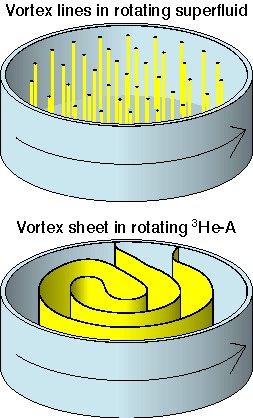Vortex Sheet in Superfluid 3He-A
 A new state of rotating superfluid 3He-A has been found
experimentally and explained theoretically.
Usually superfluids respond to rotation by creating an array of vortex lines.
The lines are parallel to the rotation axis, and
the circulation around them is quantized.
The new state consists of a vortex sheet,
where the vorticity is located on a 2 dimensional sheet instead of 1 D lines.
In contrast to other superfluids, the sheet is stable in the A phase
because of its internal structure. The sheet has as a backbone
a topologically stable domain wall called
soliton.
Non-singular vorticity is then bound to the soliton.
The structure of the vortex sheet is calculated by means of
variational approximations. This allows calculation of the
frequency shifts and the amplitudes of NMR satellite peaks.
The calculations are in good agreement with experiments.
The vortex sheet is one out of
six different vortex types in superfluid 3He-A.
A new state of rotating superfluid 3He-A has been found
experimentally and explained theoretically.
Usually superfluids respond to rotation by creating an array of vortex lines.
The lines are parallel to the rotation axis, and
the circulation around them is quantized.
The new state consists of a vortex sheet,
where the vorticity is located on a 2 dimensional sheet instead of 1 D lines.
In contrast to other superfluids, the sheet is stable in the A phase
because of its internal structure. The sheet has as a backbone
a topologically stable domain wall called
soliton.
Non-singular vorticity is then bound to the soliton.
The structure of the vortex sheet is calculated by means of
variational approximations. This allows calculation of the
frequency shifts and the amplitudes of NMR satellite peaks.
The calculations are in good agreement with experiments.
The vortex sheet is one out of
six different vortex types in superfluid 3He-A.
In a rotating container the vortex sheet is parallel to the rotation axis z
but in the x-y plane it folds to equidistant layers.
The distance between the layers is larger but on the same order
of magnitude as the distance between vortex lines.
The folding of the vortex sheet is studied by numerical simulations.
The lines where the vortex sheet touches the side wall are essential for
the response of the sheet to changes in the rotation velocity. The figure
here has only one sheet and two connection lines. By modulating the
rotation velocity it is possible to create a state that has more
connection lines, and thus faster response to changes in the
rotation velocity.
A different type of vortex sheet occurs on
the interface of A and B phases.
Publications
- ‹. Parts, E.V. Thuneberg, G.E. Volovik, J.H. Koivuniemi, V.M.H.
Ruutu, M. Heinilš, J.M. Karimški, and M. Krusius: Vortex sheet in
rotating superfluid 3He-A,
Phys. Rev. Lett. 72, 3839 (1994).
- ‹. Parts, J.H. Koivuniemi, M. Krusius, V.M.H. Ruutu, E.V.
Thuneberg, and G.E. Volovik: Bragg reflection from equidistant
planes of vortex-sheets in rotating 3He-A,
Pis'ma Zh. Eksp. Teor. Fiz. 59, 816 (1994)
[JETP Lett. 59, 851 (1994)].
- E.V. Thuneberg: Introduction to the vortex sheet of superfluid
3He-A, Physica B 210, 287 (1995).
- M.T. Heinilä and G.E. Volovik, Bifurcations in the growth
process of a vortex sheet in rotating superfluid, Physica B 210,
300 (1995).
- ‹. Parts, V.M.H. Ruutu, J.H. Koivuniemi, M. Krusius, E.V.
Thuneberg, and G.E. Volovik: Measurements on the vortex sheet in
rotating superfluid 3He-A, Physica B 210, 311 (1995).
- E.V. Thuneberg: Vortex sheet in superfluid 3He-A,
Czechoslovak J. Phys. 46 Suppl., 2937 (1996).
- O.V. Lounasmaa and E. Thuneberg: Vortices in rotating
superfluid 3He,
Proc. Natl. Acad. Sci. USA 96, 7760 (1999).
- V.B. Eltsov, R. Blaauwgeers, M. Krusius, J.J. Ruohio,
and R. Schanen: Dynamic response of the equilibrium vortex
sheet in rotating 3He-A, Physica B 284-288, 252 (2000).
- V.B. Eltsov, R. Blaauwgeers, N.B. Kopnin, M. Krusius, J.J. Ruohio,
R. Schanen, and E.V. Thuneberg:
Transitions from vortex lines to sheets: interplay of topology and
dynamics in an anisotropic superfluid,
Phys. Rev. Lett. 88, 65301 (2002),
cond-mat/0109092.
Back to helium theory page
29.1.2002, Erkki Thuneberg,
Email
 A new state of rotating superfluid 3He-A has been found
experimentally and explained theoretically.
Usually superfluids respond to rotation by creating an array of vortex lines.
The lines are parallel to the rotation axis, and
the circulation around them is quantized.
The new state consists of a vortex sheet,
where the vorticity is located on a 2 dimensional sheet instead of 1 D lines.
In contrast to other superfluids, the sheet is stable in the A phase
because of its internal structure. The sheet has as a backbone
a topologically stable domain wall called
soliton.
Non-singular vorticity is then bound to the soliton.
The structure of the vortex sheet is calculated by means of
variational approximations. This allows calculation of the
frequency shifts and the amplitudes of NMR satellite peaks.
The calculations are in good agreement with experiments.
The vortex sheet is one out of
six different vortex types in superfluid 3He-A.
A new state of rotating superfluid 3He-A has been found
experimentally and explained theoretically.
Usually superfluids respond to rotation by creating an array of vortex lines.
The lines are parallel to the rotation axis, and
the circulation around them is quantized.
The new state consists of a vortex sheet,
where the vorticity is located on a 2 dimensional sheet instead of 1 D lines.
In contrast to other superfluids, the sheet is stable in the A phase
because of its internal structure. The sheet has as a backbone
a topologically stable domain wall called
soliton.
Non-singular vorticity is then bound to the soliton.
The structure of the vortex sheet is calculated by means of
variational approximations. This allows calculation of the
frequency shifts and the amplitudes of NMR satellite peaks.
The calculations are in good agreement with experiments.
The vortex sheet is one out of
six different vortex types in superfluid 3He-A.